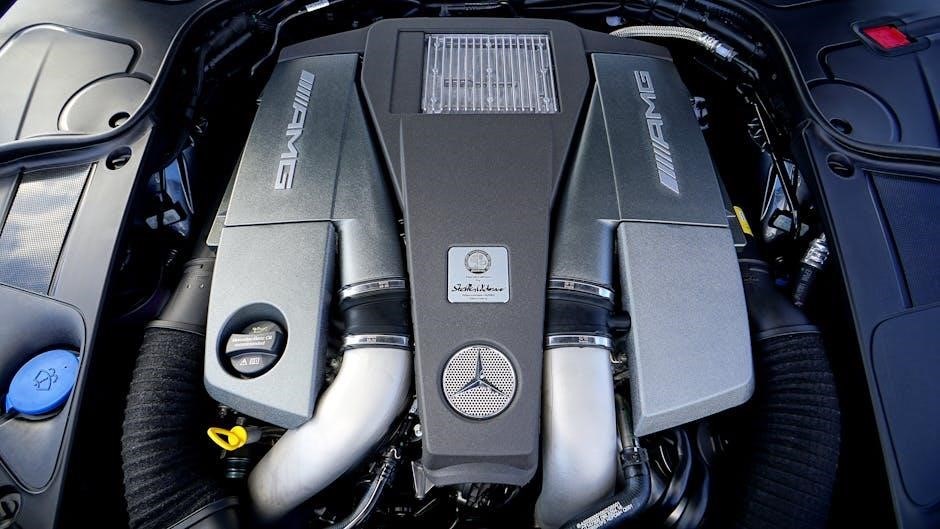Overview of the 3-Speed GM Manual Transmission
The 3-speed GM manual transmission, produced by Saginaw, is a durable and reliable gearbox designed for light-duty applications. It features a straightforward gear ratio setup, making it suitable for classic GM vehicles with smaller engines. Known for its simplicity and ease of maintenance, this transmission has become a favorite among enthusiasts for its smooth shifting and compatibility with various engine configurations. Its design emphasizes functionality, catering to drivers seeking a hands-on driving experience without the complexity of modern multi-speed systems.
1.1 Definition and Purpose
The 3-speed GM manual transmission is a lightweight, mechanically simple gearbox designed for seamless driver control. Its primary purpose is to provide a straightforward, hands-on shifting experience, ideal for smaller GM engines. This transmission is engineered for light-duty applications, offering a balance of fuel efficiency and performance. It caters to drivers who prefer manual control over gear changes, making it a practical choice for city driving and occasional highway use. Its design emphasizes durability and ease of operation, ensuring reliability in various classic and compact GM vehicle configurations.
1.2 Historical Background
The 3-speed GM manual transmission was developed during the 1960s by Saginaw, a division of General Motors. It was designed for small to medium-sized vehicles, offering simplicity and durability. Widely used in classic models like the Chevrolet Bel Air and GMC trucks, it became a staple in GM’s lineup throughout the 1960s and 1970s. Known for its ease of maintenance and smooth shifting, this transmission was favored for its reliability in both city and highway driving. It remained popular until the late 1970s when 4-speed and automatic transmissions gained prominence.
1.3 Key Features and Benefits
The 3-speed GM manual transmission offers a simple yet efficient design with well-spaced gear ratios, ideal for small to medium engines. Its compact structure reduces weight and enhances fuel efficiency. The transmission features a durable construction with minimal moving parts, ensuring reliability and reducing maintenance needs. Smooth shifting and direct driver control make it a popular choice for classic vehicles. Its compatibility with various GM models and engines adds versatility, while its straightforward design appeals to enthusiasts and DIY mechanics alike.

Design and Architecture
The 3-speed GM manual transmission features a longitudinal design with a cast-iron case, offering durability and strength. Its gearsets and shafts are engineered for smooth operation, ensuring reliable performance across various driving conditions.
2.1 Mechanical Components
The 3-speed GM manual transmission features a cast-iron case for durability, housing gearsets mounted on shafts. The mainshaft and countershaft are key components, with bearings ensuring smooth operation. A detent system controls gear engagement, while synchro rings facilitate shifting. The transmission includes a clutch assembly for manual control, with gears designed for specific ratios. Its robust architecture supports light-duty applications, making it compatible with various classic GM engines and configurations.
2.2 Gear Ratios and Specifications
The 3-speed GM manual transmission typically features a wide-ratio gear setup, with first gear at 3.50:1, second gear at 1.94:1, and third gear at 1.00:1. The reverse gear ratio is also 3.50:1. Designed for light-duty applications, it supports engines up to 300 horsepower and is compatible with various final drive ratios, providing flexibility for different vehicle setups. Its specifications ensure smooth power delivery and efficient shifting, making it ideal for classic GM vehicles requiring a balance of performance and simplicity.
2.3 Lubrication and Cooling Systems
The 3-speed GM manual transmission relies on a simple yet effective lubrication system, typically using a high-quality gear oil to reduce friction and wear on internal components. The transmission is splash-lubricated, with gears distributing oil throughout the unit. Cooling is primarily achieved through natural airflow around the transmission case, though some models may incorporate an external cooler for added thermal management. Proper maintenance, including regular fluid checks and changes, is crucial to ensure optimal performance and longevity of the gearbox.

Maintenance and Repair
Regular maintenance for the 3-speed GM manual transmission includes checking and replacing gear oil to prevent wear and overheating. Repairs often involve replacing seals or bearings.
3.1 Regular Maintenance Tips
Regular maintenance of the 3-speed GM manual transmission involves checking gear oil levels and condition, ensuring proper lubrication to prevent wear and overheating. Inspect the transmission pan gasket for leaks and replace it if necessary. Flush and refill the gearbox with the recommended gear oil every 30,000 to 50,000 miles. Additionally, monitor the clutch pedal for smooth engagement and adjust as needed. Replace worn-out seals or bearings promptly to avoid further damage. Regular inspection of the transmission mounts and linkage ensures optimal performance and longevity.
- Check gear oil levels regularly.
- Inspect for leaks and wear.
- Replace seals and bearings as needed.
3.2 Common Issues and Solutions
Common issues with the 3-speed GM manual transmission include gear slippage, noisy operation, and fluid leaks. Gear slippage often results from worn-out synchronizers or low transmission fluid levels. Noisy operation can stem from damaged bearings or insufficient lubrication. Fluid leaks typically occur from the transmission pan gasket or seals. Solutions include replacing worn components, replenishing gear oil, and sealing leaks promptly. Regular inspections and timely repairs can prevent these issues from escalating, ensuring smooth and reliable performance.
- Inspect and replace worn synchronizers.
- Check and top off gear oil levels.
- Replace faulty gaskets or seals.
3.3 Rebuilding and Restoration
Rebuilding the 3-speed GM manual transmission involves disassembling, inspecting, and replacing worn components like bearings, seals, and synchronizers. Specialized tools and reference manuals are essential for accuracy. The process ensures improved performance and reliability, making it a cost-effective alternative to replacement. Proper reassembly and alignment are critical for smooth operation.
- Disassemble and inspect internal components.
- Replace worn bearings, seals, and synchronizers.
- Reassemble with precision and test functionality.

Performance and Upgrades
The 3-speed GM manual transmission offers a classic driving experience, ideal for vintage vehicles. Upgrades like high-performance gear sets and aftermarket components enhance its durability and shifting precision, catering to enthusiasts seeking improved acceleration and control while maintaining its traditional feel.
4.1 Enhancing Speed and Acceleration
Enhancing the speed and acceleration of the 3-speed GM manual transmission involves optimizing gear ratios and reducing weight. Upgrading to a closer-ratio gear set improves acceleration by maximizing torque delivery. Lightweight components, such as aluminum gear clusters, can reduce rotational mass, enhancing responsiveness. Additionally, installing a high-performance clutch kit ensures smoother and quicker shifts, directly translating to better acceleration. Proper alignment and tuning of the transmission with the engine’s power band are crucial for achieving optimal performance without compromising drivability or durability.
4.2 Customization and Aftermarket Parts
The 3-speed GM manual transmission can be customized with aftermarket parts to enhance performance and durability. Popular upgrades include high-strength gear sets, lightweight aluminum components, and performance clutch kits. Aftermarket shifters and short-throw adapters improve shifting precision and reduce throw distance. Additionally, enthusiasts often install high-performance bearings and seals to reduce friction and extend transmission life. Custom gear ratios can also be tailored for specific applications, such as racing or heavy-duty use, ensuring optimal power delivery and drivetrain efficiency.
4.3 Shifting Techniques for Optimal Performance
Mastering shifting techniques is crucial for optimal performance with the 3-speed GM manual transmission. Smooth acceleration begins with gradual clutch engagement and shifting at the right RPM to avoid lugging the engine. Shift into higher gears between 2,500-3,000 RPM for balanced power delivery. When decelerating, downshift before entering turns or stopping to maintain control and avoid braking strain. Avoid “riding the clutch” to preserve transmission longevity. Proper shifting enhances fuel efficiency, reduces wear, and provides a more engaging driving experience, especially in classic or vintage GM vehicles equipped with this transmission.
Compatibility and Applications
The 3-speed GM manual transmission is compatible with various classic GM models, including Chevrolet and Pontiac vehicles, and is ideal for smaller engine configurations and light-duty applications.
5.1 Compatible GM Vehicle Models
The 3-speed GM manual transmission is widely compatible with classic GM vehicles, including Chevrolet models like the Camaro, Nova, and Bel Air, as well as Pontiac and Oldsmobile cars. It was also used in the Vauxhall Cavalier (1982-1988) and certain light-duty trucks. This transmission pairs well with smaller engines, such as the 250 inline-six and 283 V8, making it a popular choice for enthusiasts of vintage GM vehicles. Its simplicity ensures reliability across various applications, from daily drivers to restoration projects.
5.2 Engine Pairing and Compatibility
The 3-speed GM manual transmission is ideally paired with smaller engines, such as the 250 inline-six and 283 V8, due to its light-duty design. This gearbox is compatible with engines producing moderate torque and horsepower, making it a versatile option for classic GM vehicles. The transmission’s gear ratios are optimized for efficient performance with these engines, ensuring smooth acceleration and fuel efficiency. Its compatibility extends to both passenger cars and light-duty trucks, making it a practical choice for a variety of applications.
5.3 Specialized Uses in Racing and Vintage Cars
The 3-speed GM manual transmission is often sought after for racing and vintage car applications due to its simplicity and durability. Its lightweight design and compact size make it ideal for lightweight racing vehicles, while its straightforward gear setup allows for quick shifts and reliable performance. Vintage car enthusiasts favor this transmission for its classic feel and compatibility with older engines, preserving the authentic driving experience of heritage vehicles. Additionally, its ease of maintenance and rebuildability make it a practical choice for both track and classic car use.

Transmission Identification and Codes
The 3-speed GM manual transmission can be identified by its unique identification codes, typically starting with ‘S’ for Saginaw models. These codes help enthusiasts and mechanics distinguish it from other transmissions, ensuring proper maintenance and parts compatibility.
6.1 Understanding Transmission Codes
Transmission codes are essential for identifying the 3-speed GM manual transmission. These codes, often starting with “S” for Saginaw models, provide details about the transmission’s specifications, manufacturer, and compatibility. They typically include letters and numbers that denote gear ratios, production dates, and specific vehicle applications. For example, a code like “SAG-3S” might indicate a Saginaw 3-speed manual transmission designed for a particular engine or vehicle model. Understanding these codes helps mechanics and enthusiasts accurately identify and maintain the transmission, ensuring proper repairs and parts compatibility.

6.2 Visual Identification Guide
The 3-speed GM manual transmission can be visually identified by its compact size and distinct design features. It typically has a rounded or curved side cover with a 4-bolt or 9-bolt pattern, depending on the model. The gear selection shaft is usually located on the top or side, and the transmission case is often made of cast aluminum. Look for the “Saginaw” name or GM part numbers stamped on the case. The tailshaft length and mounting points can also help confirm its identity. These visual cues make it easier to distinguish from other transmissions.
6.3 Cross-Referencing with GM Part Numbers
The 3-speed GM manual transmission can be identified using its specific part numbers and codes. Saginaw 3-speed transmissions often start with “S,” while 4-speed models begin with “O.” For example, the M21 and M40 transmissions are commonly referenced by their GM part numbers. Cross-referencing these numbers with official GM documentation or parts catalogs ensures accurate identification. This method helps enthusiasts and mechanics verify compatibility and specifications when rebuilding or replacing the transmission in classic GM vehicles. Always consult GM’s official resources for the most reliable information.

DIY Installation and Setup
Installing a 3-speed GM manual transmission requires specialized tools and a detailed step-by-step guide. Ensure proper alignment, secure mounting, and precise gear adjustment for smooth operation.
7.1 Tools and Equipment Required
Installing a 3-speed GM manual transmission requires a hydraulic jack, jack stands, wrenches, sockets, a torque wrench, and a transmission jack or cherry picker. Driveshaft removal tools, a gear puller, screwdrivers, pliers, and punches are also essential. Safety gear like gloves and safety glasses is crucial. A drain pan, new transmission filter, and gasket set are needed for proper installation. Specialized tools for the Saginaw design may be necessary; Ensure all tools are available to handle the transmission’s weight and specific bolts effectively for a safe and successful installation.
7.2 Step-by-Step Installation Guide
Begin by raising the vehicle and removing the old transmission. Disconnect the driveshaft, shift linkage, and clutch assembly. Use a transmission jack to lower the old unit. Inspect and clean the bellhousing. Install the new transmission, aligning the splines carefully. Secure it with mounting bolts, ensuring proper torque specifications. Reconnect the driveshaft, shift linkage, and clutch. Refill the transmission fluid and bleed the system if necessary. Test all gears to ensure smooth operation. Follow proper safety guidelines throughout the process to avoid injuries or damage.
7.3 Post-Installation Testing and Adjustments
After installation, test the transmission by shifting through all gears to ensure smooth operation. Check for any leaks around the seal and gasket areas. Adjust the clutch pedal free play and ensure proper engagement. Verify the neutral safety switch functionality to prevent accidental starting in gear. Take the vehicle for a test drive, monitoring acceleration and shifting smoothness. Address any unusual noises or vibrations promptly. Finally, review the entire system to ensure all components are securely connected and functioning as intended for optimal performance and reliability.

Comparison with Other Transmissions
The 3-speed GM manual transmission is known for its simplicity and reliability compared to modern multi-speed units. It offers smooth shifting and compatibility with classic engines but lacks the fuel efficiency and gear flexibility of contemporary transmissions like the 4-speed or automatic options.
8.1 4-Speed vs. 3-Speed Manual Transmissions
The 4-speed manual transmission offers an additional gear ratio compared to the 3-speed, improving fuel efficiency and performance, especially at higher speeds. The 4-speed typically includes a wider range of gear ratios, allowing for better acceleration and smoother shifting between gears. In contrast, the 3-speed is simpler in design, with fewer components, making it more reliable and easier to maintain. However, the 3-speed lacks the flexibility of the 4-speed, particularly in modern driving conditions where engine torque and speed variations are more pronounced. Both transmissions cater to different driver preferences and vehicle requirements.
- 4-speed: Better fuel efficiency and performance at higher speeds.
- 3-speed: Simpler design, greater reliability, and lower maintenance.
8.2 Automatic vs. Manual Transmission Pros and Cons
Manual transmissions, like the 3-speed GM, offer better fuel efficiency, lower production costs, and greater driver control, making them popular among enthusiasts. However, they require more skill and can be less convenient in heavy traffic. Automatic transmissions provide ease of use, smoother acceleration, and reduced driver fatigue, especially in urban driving. Yet, they are generally heavier, less fuel-efficient, and more expensive to maintain. The choice depends on driving habits, priorities, and the desired driving experience.
- Manual: Better fuel efficiency, lower cost, and driver engagement.
- Automatic: Convenience, smooth operation, and reduced fatigue.
8.3 Performance Comparison with Modern Transmissions
The 3-speed GM manual transmission, while reliable, lacks the sophistication of modern transmissions. Contemporary units often feature more gears, advanced materials, and optimized gear ratios for better acceleration and fuel efficiency. Modern transmissions also incorporate electronic controls and adaptive shifting, enhancing performance and drivability. However, the simplicity of the 3-speed design appeals to enthusiasts who prefer a more direct driving experience. Despite its limitations, it remains a viable option for classic vehicles, offering a unique charm that modern systems cannot replicate.
- Modern transmissions: Higher gear count, better efficiency, and advanced technology.
- 3-speed GM: Simplicity, durability, and nostalgic appeal.

Troubleshooting and Common Problems
The 3-speed GM manual transmission may experience issues like gear noise, fluid leaks, or missed shifts. Regular maintenance and proper lubrication are essential for longevity.
- Transmission noise often indicates worn bearings or low fluid levels.
- Fluid leaks can stem from damaged seals or gaskets;
- Missed shifts may result from clutch misalignment or worn synchros.
9.1 Diagnosing Transmission Noise
Diagnosing noise in the 3-speed GM manual transmission involves identifying the source, such as bearings, gears, or input shaft. Common causes include low fluid levels, worn bearings, or damaged gear teeth.
- Clunking or grinding: Often indicates worn or damaged gears during shifting.
- Whining or humming: Typically points to bearing wear or improper lubrication.
- Rattling: May suggest loose components or insufficient fluid.
A thorough inspection, including visual checks and test drives, helps pinpoint the issue for effective repair.
9.2 Addressing Gear Slippage and Missed Shifts
Gear slippage and missed shifts in the 3-speed GM manual transmission often stem from worn clutch components, low transmission fluid levels, or misaligned shift linkage. To resolve this, inspect the clutch for wear and replace if necessary. Check and top off the transmission fluid to ensure proper lubrication. Adjust the shift linkage to eliminate play and ensure accurate gear engagement. In severe cases, rebuilding the transmission with new bearings and synchronizers may be required to restore smooth operation and prevent further damage.
9.3 Solving Leaks and Fluid Loss Issues
Leaks in the 3-speed GM manual transmission are often caused by worn gaskets or seals. Inspect the transmission pan, input shaft, and rear seal for signs of damage or wear. Replace the gasket set if fluid is seeping from the pan. Tighten loose pan bolts or replace them if stripped. For persistent leaks, apply a high-quality RTV sealant to ensure a tight seal. After repairs, refill the transmission with the recommended fluid and test for leaks under operation. Regularly checking fluid levels can prevent damage from low lubrication.

Resources and Community Support
Online forums, repair manuals, and professional workshops provide extensive support for 3-speed GM manual transmission owners, offering troubleshooting guides, parts sourcing, and expert advice for maintenance and upgrades.
10.1 Online Forums and Communities
Online forums and communities are invaluable resources for 3-speed GM manual transmission enthusiasts. Platforms like Reddit’s r/TransmissionPros and specialized automotive forums offer technical discussions, DIY guides, and troubleshooting tips. Members share experiences, repair manuals, and advice, fostering a supportive environment for maintenance and upgrades. These communities often include experts and hobbyists who provide detailed insights into transmission repair and customization. Additionally, Facebook groups and classic car forums dedicate sections to vintage GM transmissions, offering a wealth of knowledge and parts sourcing tips for enthusiasts.
10.2 Repair Manuals and Documentation
Repair manuals and documentation for the 3-speed GM manual transmission are essential for DIY enthusiasts and professionals. Factory-authorized service manuals, such as those from GM or Saginaw, provide detailed instructions for disassembly, inspection, and reassembly. These guides include torque specifications, gear ratio charts, and exploded diagrams, ensuring accurate repairs. Additionally, aftermarket manuals from trusted publishers offer step-by-step procedures and troubleshooting tips. Online resources like Summit Racing and Transmission Rebuild Kits also supply PDF guides and technical bulletins, making it easier to restore or upgrade the transmission effectively.
10.3 Professional Services and Workshops
Professional services and workshops specialize in repairing, rebuilding, and upgrading the 3-speed GM manual transmission. Experts at transmission shops like Summit Racing and Tremec offer tailored solutions, ensuring optimal performance. These workshops use genuine parts from trusted manufacturers like Borg-Warner to maintain reliability. Skilled technicians provide diagnostics, custom gearing, and restoration services, catering to both enthusiasts and classic car owners. Their expertise ensures precise repairs and upgrades, making them invaluable for maintaining or enhancing the transmission’s functionality and longevity.
